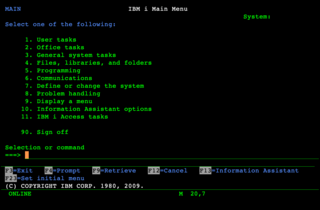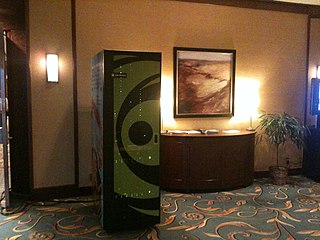
In computing, a database is an organized collection of data or a type of data store based on the use of a database management system (DBMS), the software that interacts with end users, applications, and the database itself to capture and analyze the data. The DBMS additionally encompasses the core facilities provided to administer the database. The sum total of the database, the DBMS and the associated applications can be referred to as a database system. Often the term "database" is also used loosely to refer to any of the DBMS, the database system or an application associated with the database.

Microsoft Access is a database management system (DBMS) from Microsoft that combines the relational Access Database Engine (ACE) with a graphical user interface and software-development tools. It is a member of the Microsoft 365 suite of applications, included in the Professional and higher editions or sold separately.
A relational database (RDB) is a database based on the relational model of data, as proposed by E. F. Codd in 1970.
Structured Query Language (SQL) is a domain-specific language used to manage data, especially in a relational database management system (RDBMS). It is particularly useful in handling structured data, i.e., data incorporating relations among entities and variables.

Db2 is a family of data management products, including database servers, developed by IBM. It initially supported the relational model, but was extended to support object–relational features and non-relational structures like JSON and XML. The brand name was originally styled as DB2 until 2017, when it changed to its present form.

IBM i is an operating system developed by IBM for IBM Power Systems. It was originally released in 1988 as OS/400, as the sole operating system of the IBM AS/400 line of systems. It was renamed to i5/OS in 2004, before being renamed a second time to IBM i in 2008. It is an evolution of the System/38 CPF operating system, with compatibility layers for System/36 SSP and AIX applications. It inherits a number of distinctive features from the System/38 platform, including the Machine Interface which provides hardware independence, the implementation of object-based addressing on top of a single-level store, and the tight integration of a relational database into the operating system.

In computing, SQL injection is a code injection technique used to attack data-driven applications, in which malicious SQL statements are inserted into an entry field for execution. SQL injection must exploit a security vulnerability in an application's software, for example, when user input is either incorrectly filtered for string literal escape characters embedded in SQL statements or user input is not strongly typed and unexpectedly executed. SQL injection is mostly known as an attack vector for websites but can be used to attack any type of SQL database.

A data dictionary, or metadata repository, as defined in the IBM Dictionary of Computing, is a "centralized repository of information about data such as meaning, relationships to other data, origin, usage, and format". Oracle defines it as a collection of tables with metadata. The term can have one of several closely related meanings pertaining to databases and database management systems (DBMS):
A database abstraction layer is an application programming interface which unifies the communication between a computer application and databases such as SQL Server, IBM Db2, MySQL, PostgreSQL, Oracle or SQLite. Traditionally, all database vendors provide their own interface that is tailored to their products. It is up to the application programmer to implement code for the database interfaces that will be supported by the application. Database abstraction layers reduce the amount of work by providing a consistent API to the developer and hide the database specifics behind this interface as much as possible. There exist many abstraction layers with different interfaces in numerous programming languages. If an application has such a layer built in, it is called database-agnostic.
A federated database system (FDBS) is a type of meta-database management system (DBMS), which transparently maps multiple autonomous database systems into a single federated database. The constituent databases are interconnected via a computer network and may be geographically decentralized. Since the constituent database systems remain autonomous, a federated database system is a contrastable alternative to the task of merging several disparate databases. A federated database, or virtual database, is a composite of all constituent databases in a federated database system. There is no actual data integration in the constituent disparate databases as a result of data federation.
In a database, a view is the result set of a stored query that presents a limited perspective of the database to a user. This pre-established query command is kept in the data dictionary. Unlike ordinary base tables in a relational database, a view does not form part of the physical schema: as a result set, it is a virtual table computed or collated dynamically from data in the database when access to that view is requested. Changes applied to the data in a relevant underlying table are reflected in the data shown in subsequent invocations of the view.
UIMA, short for Unstructured Information Management Architecture, is an OASIS standard for content analytics, originally developed at IBM. It provides a component software architecture for the development, discovery, composition, and deployment of multi-modal analytics for the analysis of unstructured information and integration with search technologies.

Unicom System Architect is an enterprise architecture tool that is used by the business and technology departments of corporations and government agencies to model their business operations and the systems, applications, and databases that support them. System Architect is used to build architectures using various frameworks including TOGAF, ArchiMate, DoDAF, MODAF, NAF and standard method notations such as sysML, UML, BPMN, and relational data modeling. System Architect is developed by UNICOM Systems, a division of UNICOM Global, a United States–based company.
A Web query topic classification/categorization is a problem in information science. The task is to assign a Web search query to one or more predefined categories, based on its topics. The importance of query classification is underscored by many services provided by Web search. A direct application is to provide better search result pages for users with interests of different categories. For example, the users issuing a Web query "apple" might expect to see Web pages related to the fruit apple, or they may prefer to see products or news related to the computer company. Online advertisement services can rely on the query classification results to promote different products more accurately. Search result pages can be grouped according to the categories predicted by a query classification algorithm. However, the computation of query classification is non-trivial. Different from the document classification tasks, queries submitted by Web search users are usually short and ambiguous; also the meanings of the queries are evolving over time. Therefore, query topic classification is much more difficult than traditional document classification tasks.

IBM Netezza is a subsidiary of American technology company IBM that designs and markets high-performance data warehouse appliances and advanced analytics applications for the most demanding analytic uses including enterprise data warehousing, business intelligence, predictive analytics and business continuity planning.
A graph database (GDB) is a database that uses graph structures for semantic queries with nodes, edges, and properties to represent and store data. A key concept of the system is the graph. The graph relates the data items in the store to a collection of nodes and edges, the edges representing the relationships between the nodes. The relationships allow data in the store to be linked together directly and, in many cases, retrieved with one operation. Graph databases hold the relationships between data as a priority. Querying relationships is fast because they are perpetually stored in the database. Relationships can be intuitively visualized using graph databases, making them useful for heavily inter-connected data.

IBM Cognos Analytics with Watson is a web-based integrated business intelligence suite by IBM. It provides a toolset for reporting, analytics, scorecarding, and monitoring of events and metrics. The software consists of several components designed to meet the different information requirements in a company. IBM Cognos Analytics has components such as IBM Cognos Framework Manager, IBM Cognos Cube Designer, IBM Cognos Transformer.

Apache Drill is an open-source software framework that supports data-intensive distributed applications for interactive analysis of large-scale datasets. Built chiefly by contributions from developers from MapR, Drill is inspired by Google's Dremel system. Drill is an Apache top-level project. Tom Shiran is the founder of the Apache Drill Project. It was designated an Apache Software Foundation top-level project in December 2016.
Rocket U2 is a suite of database management (DBMS) and supporting software now owned by Rocket Software. It includes two MultiValue database platforms: UniData and UniVerse. Both of these products are operating environments which run on current Unix, Linux and Windows operating systems. They are both derivatives of the Pick operating system. The family also includes developer and web-enabling technologies including SB/XA, U2 Web Development Environment (WebDE), UniObjects connectivity API and wIntegrate terminal emulation software.
Contextual search is a form of optimizing web-based search results based on context provided by the user and the computer being used to enter the query. Contextual search services differ from current search engines based on traditional information retrieval that return lists of documents based on their relevance to the query. Rather, contextual search attempts to increase the precision of results based on how valuable they are to individual users.